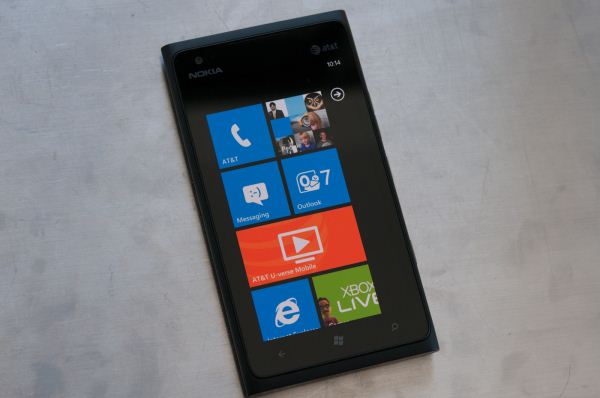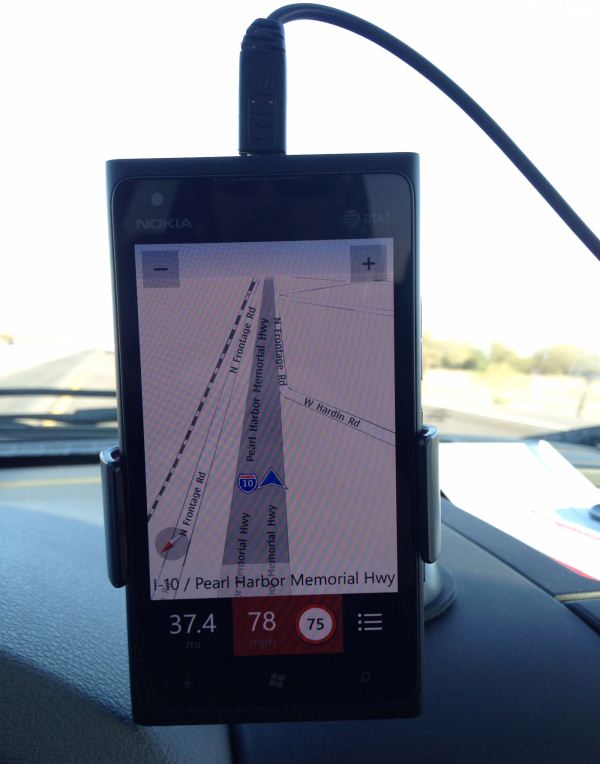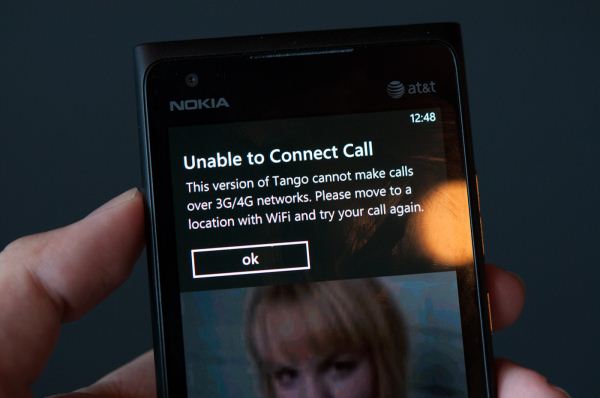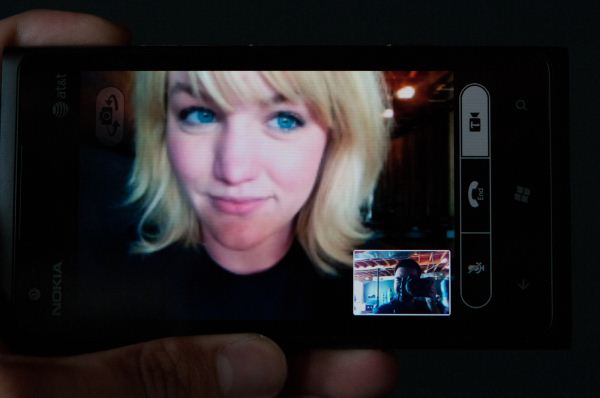Nokia Lumia 900 Review - Windows Phone with LTE
by Brian Klug on April 3, 2012 9:00 PM ESTWP7.5 and Preloaded Applications
To accommodate the Lumia 900’s unique inclusion of LTE, the device runs a newer build of WP7.5 Mango than I’ve seen on any other devices. Our sampled Lumia 900 came running 7.10.8112.7. Superficially I can’t find anything major which deviates from the WP7.5 I’ve seen on numerous other devices, other than again small changes to accommodate LTE. These boil down to inclusion of an LTE status indicator and an according change to the cellular settings page to select between EDGE / WCDMA (3G) / LTE (4G) - more on this later. We’ve gone over Windows Phone 7.5 Mango before, and what’s shipped on the Lumia 900 isn’t different from what has come before, obviously. Nokia’s input into the WP7.5 UI seems to go as far as their customized ringtones, a “Nokia Blue” theme, and the usual customization options for OEMs such as the right options under camera, marketplace link, and so forth.
As with any carrier-subsidized phone, there’s some software preload on the Lumia 900. The stuff that comes preinstalled on the Lumia 900 matches what I’ve seen on other AT&T-branded WP7 devices, namely AT&T Code Scanner, Navigator, Radio, U-Verse Mobile, an ESPN app, and YPmobile seem to be the bloat. What’s great about WP7 is that you can uninstall any of these preloaded applications and never have to see them again.
Oddly enough the only Nokia software among the preloads is the Nokia App Highlights application. The Marketplace includes a Nokia Collection shortcut as you’d expect, but there’s no preloaded Nokia Drive or Maps unless you go in the Marketplace and grab it. That’s a bit odd, but I suspect AT&T’s ulterior motive here is that it wants subscribers to use its own AT&T Navigator application (which requires a monthly subscription) rather than the free-because-it’s-a-Lumia Nokia Drive application.
I have to say that I’m impressed with how much Nokia Drive has improved since its initial launch on Windows Phone 7 with the Lumia 800. As of this writing the version is 2.0.0.2148, and it feels much more polished and responsive now since last I used it, and includes a few new features. The current version still requires you to preload maps for the regions you want over WiFi (so be sure you do this before getting in the car), but you basically get the ability to pre-cache whatever maps you want instead of hoping you have network connectivity where you’re going like with Google Navigation.
I took a small road trip up to Phoenix to test AT&T LTE and used the Lumia 900 and Nokia Drive for navigation the whole way. Again, the application feels more performant and some places where the UI had a ton of friction have been smoothed over. One of the new Nokia Drive features is showing current speed and the road’s speed limit alongside, among other things. At this point the only major gripes I have with Nokia Drive are that the application arguably should change between night and daytime map colors automatically, and that the accelerometer filtering seems to misinterpret bumps in the road as a rotation occasionally.
Nokia’s Maps application is up to version 1.3.10.230 and is still a good alternative to the default Windows Phone Maps application. Like Nokia Drive, I find it unfortunate that the application isn’t installed by default.
One of the other major preloads is Tango, a cross platform voice calling application which runs on Windows, iOS, Android, and WP7. One of Tango’s big features is that voice calling is supported 3G, 4G, and WiFi, however curiously enough the preinstalled version of Tango on the Lumia 900 doesn’t support calling over 3G or 4G cellular data.
Obviously this is an AT&T imposed restriction imposed on their subsidized hardware (at least for this variant), however it’s just annoying. I installed the marketplace version of Tango, however, which does allow calling over cellular data. This does work - again it seems pointless for AT&T to preload a version of Tango which undermines that service’s principle feature, especially when you can nuke the preloaded version in 10 seconds and install the market version without the limitation.
Regardless, I gave Tango voice calling a shot over WiFi and 3G to an iPhone client on 3G using the preinstalled application, and it does work well on the Lumia 900. The interface for Windows Phone 7 approximates the FaceTime interface, including the same front to back camera switcher overlay. At the bottom are controls for muting audio, enable/disable video, and ending the call. I can’t complain about quality, which looks about what you’d expect (perhaps QVGA or slightly higher) for a video encoded and sent over 3G data.















128 Comments
View All Comments
NeoteriX - Wednesday, April 4, 2012 - link
Google Maps:10 miles from a given point on a map.
...it's enough for all of Manhattan and nearly all of New York City.
Braumin - Wednesday, April 4, 2012 - link
My wife has the Lumia 800. It is a great phone, and the 900 just builds on that. Thank God they got rid of the magnetic door over the USB port.I'm excited to see what Nokia can bring to the table with WP8. I am a big fan of WP7.5, but I know it has some shortcomings. I can't see how those won't all be fixed with WP8 running on the Windows 8 kernel. Obviously Microsoft and Nokia don't want to talk about it (which is too bad) but for business reasons, it makes sense, but all the complaints about hardware should evaporate. Windows 8 already has support for high ppi displays, multicore, LTE, and everything else. Six months seems like a long time away.
The Lumia 900, especially at the price it is offered, should be a great phone for many people. I'll keep my old LG Optimus 7 until Apollo hits though.
j3ff86 - Wednesday, April 4, 2012 - link
174 nits of brightness is super pathetic. I bet Nokia uses a very aggressive ambient light sensor like they did on the N8 and E7. You can disable the light sensor on those phones with 3rd party software but I don't know if WP7 has similar apps.kyuu - Wednesday, April 4, 2012 - link
It's way beyond sufficient for indoor viewing... the only place you might need more brightness is outside in daylight. I guess you missed the part where Brian said that the clearblack feature was pretty effective at reducing glare/reflections and, due to that, the display was quite visible even in the outdoor daylight setting.If you can see the display clearly even in daylight, why would need or want more brightness? So you can drain the battery faster for no real benefit?
steven75 - Wednesday, April 4, 2012 - link
So it's only bad in real life situations where people use their phone? Ok, then.tipoo - Wednesday, April 4, 2012 - link
That's not what he said. The display has one of the lowest reflection indexes in a phone or tablet, its very good at reducing glare, so even if the brightness in absolute terms is lower, in real world use its pretty good since its not competing with the sun as much.ecuador - Wednesday, April 4, 2012 - link
Ehm... You have a N9 right there? Why don't you post a review? It is way too late now, but better late than never?tipoo - Wednesday, April 4, 2012 - link
It's an 800 with a dead OS. There's your review :)Beerfloat - Wednesday, April 4, 2012 - link
You mean it's an 800 but with another dead OS right :)But seriously, bring on the HTC One X review. Now there's a practically perfect smartphone.
tipoo - Wednesday, April 4, 2012 - link
Agreed, but I want the One X with Krait rather than Tegra 3, that one's not out yet.